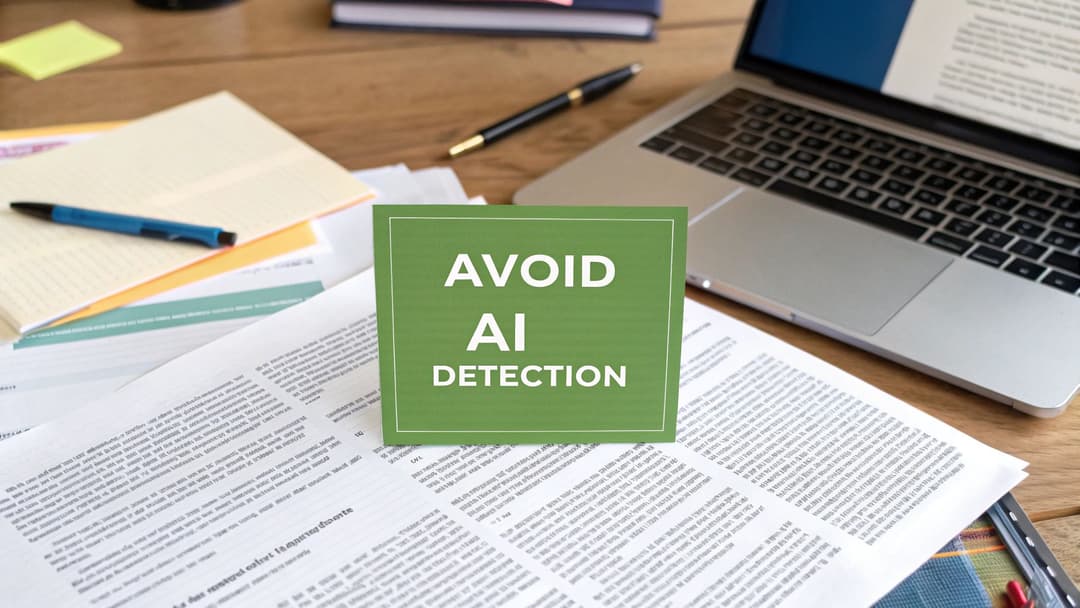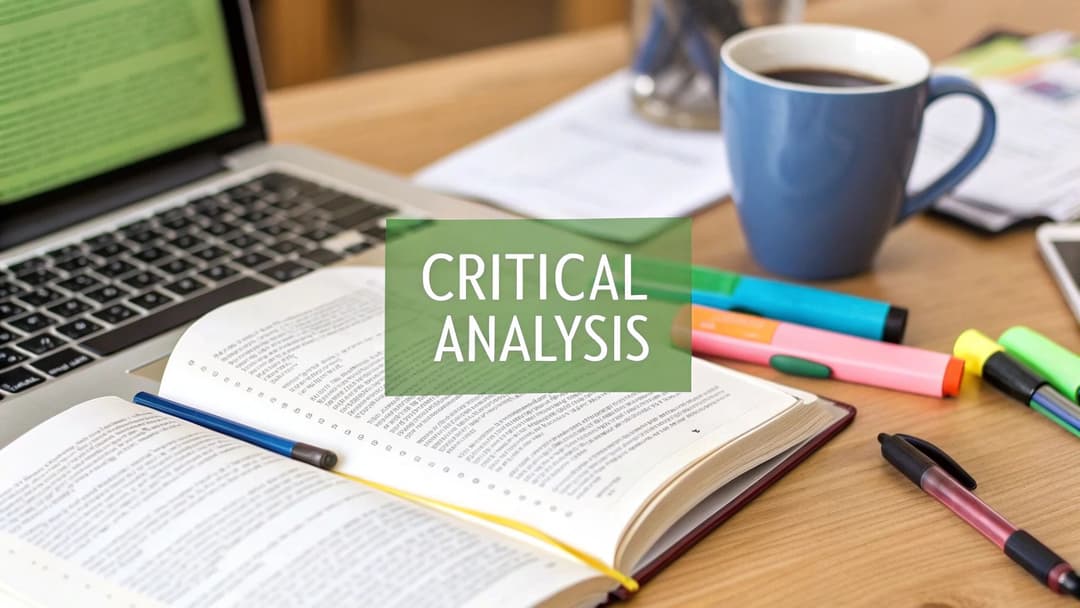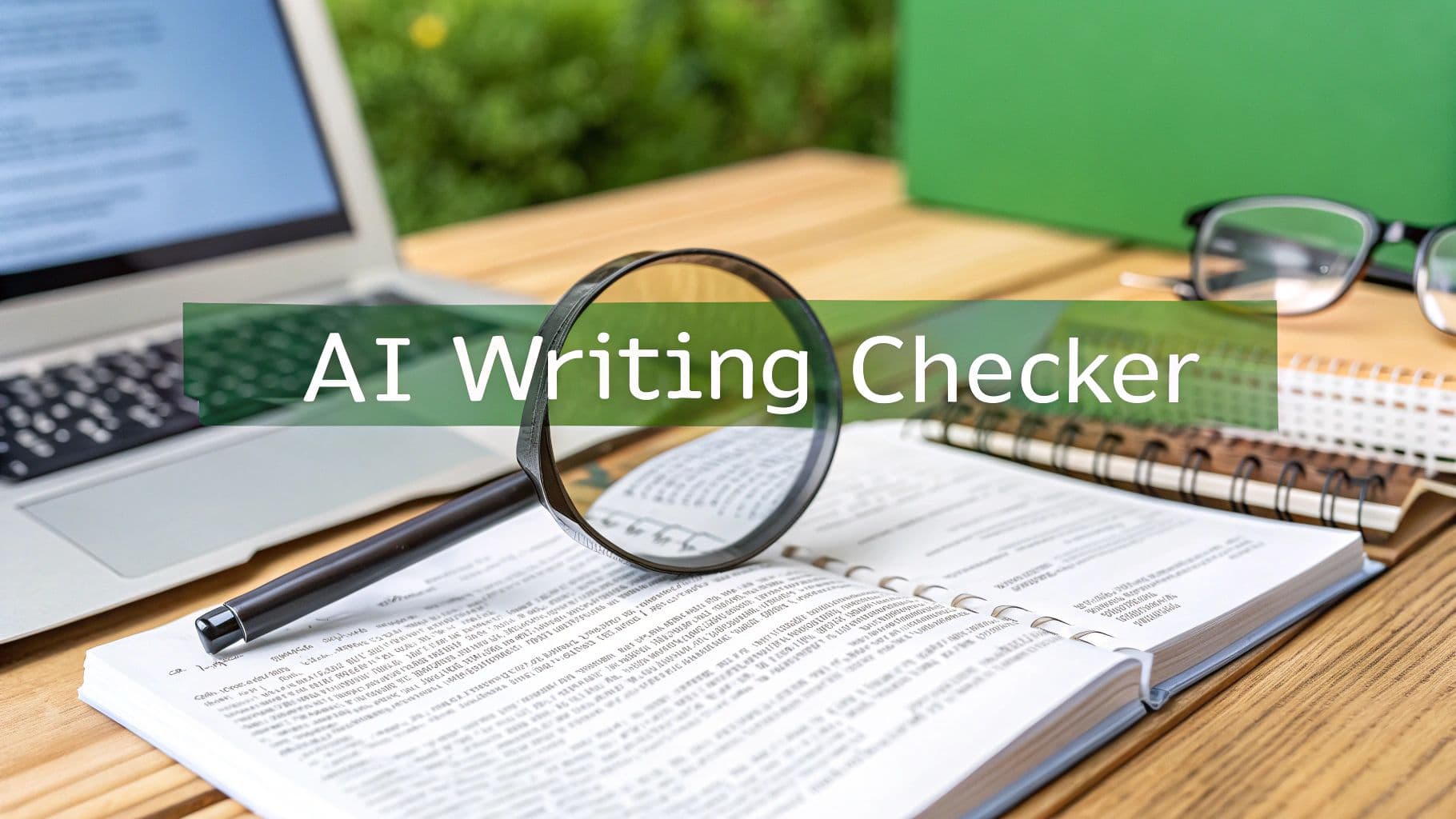
Your Guide to the AI Writing Checker
July 2, 2025
We’ve all been there. You’re staring at a draft, knowing it needs work, but you’re not quite sure where to begin. This is where an AI writing checker comes in — and not just as a grammar tool, but as a genuine co-pilot for your entire writing process.
Beyond Spellcheck: The Modern AI Writing Checker
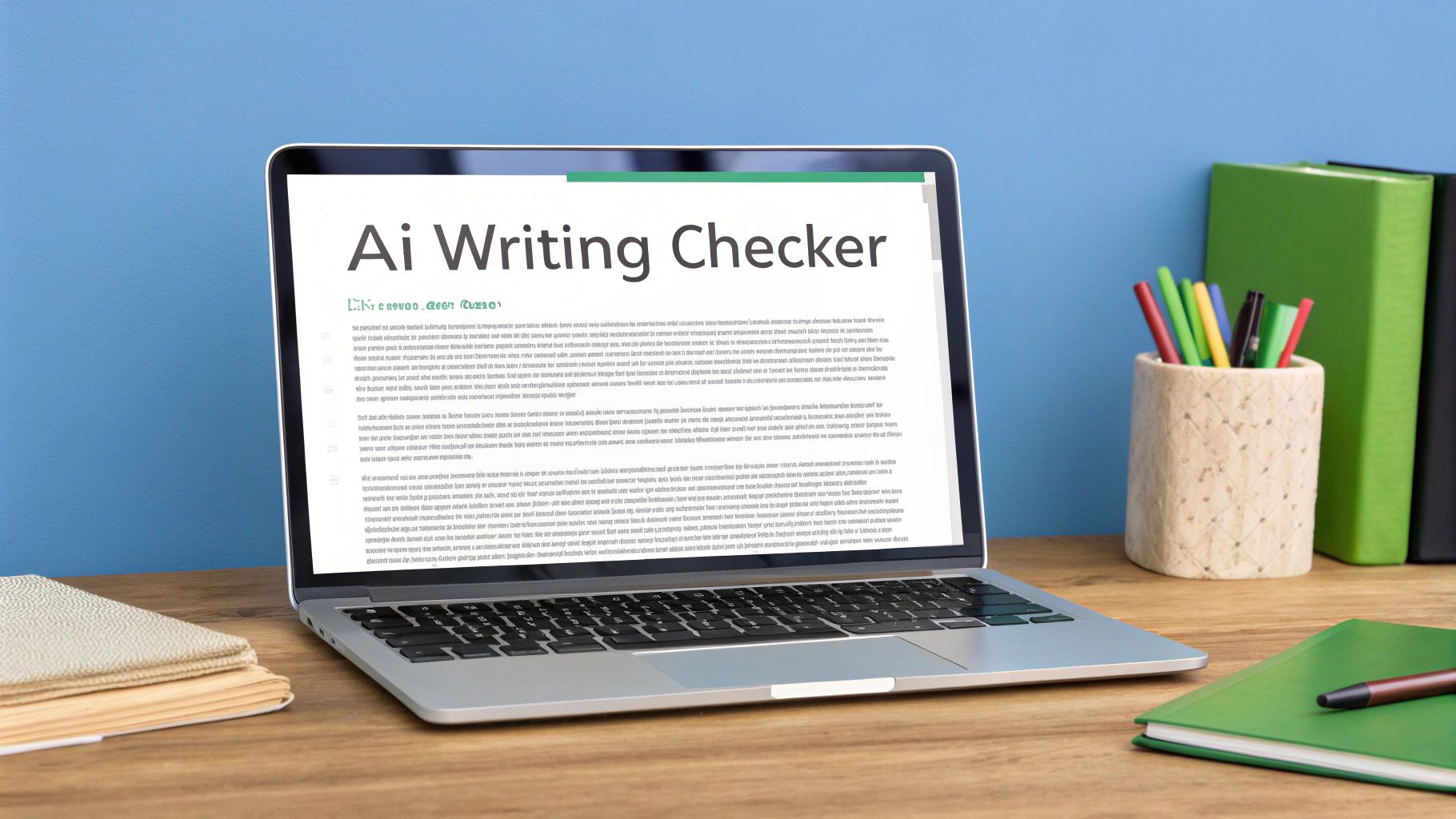
Forget the red squiggly lines you’re used to. Today's AI-powered tools are much more like a personal editor, digging into your text to analyze its deeper qualities. They move far beyond simple corrections to help you refine your tone, sharpen your clarity, and make sure your message actually connects with your audience.
This massive leap in what’s possible is why these tools are quickly becoming essential in so many fields. In fact, the global market for AI writing assistant software was valued at around USD 1.2 billion in 2023 and is on track to hit nearly USD 10 billion by 2032. That explosive growth shows just how many people are realizing their value. You can find more details in the full research on the AI writing market growth.
An AI writing checker is your partner in communication. It doesn't just fix mistakes; it helps shape your ideas into clear, compelling, and effective writing that achieves your specific goals.
Who Benefits From an AI Checker?
Just about anyone who writes can benefit. The applications are incredibly broad.
- Students: Can aim for academic excellence, ensuring their essays are clear, well-structured, and free from any hint of plagiarism.
- Marketers: Can protect their brand’s voice and craft persuasive copy that converts, keeping everything consistent across different campaigns.
- Professionals: Can draft critical communications—from important emails to detailed reports—with full confidence that their message is polished and professional.
This guide will walk you through how these checkers operate behind the scenes and, more importantly, how to pick the one that fits your needs perfectly.
How an AI Writing Checker Understands Your Text
Ever wondered how an AI writing checker just knows a sentence sounds awkward? It’s not magic. It's a combination of powerful technologies working together behind the scenes, almost like a team of digital editors. This process is what turns your raw text into something polished and effective.
The journey starts the moment you paste in your text. This simple visual breaks down the core workflow, from your keyboard to the final suggestions.
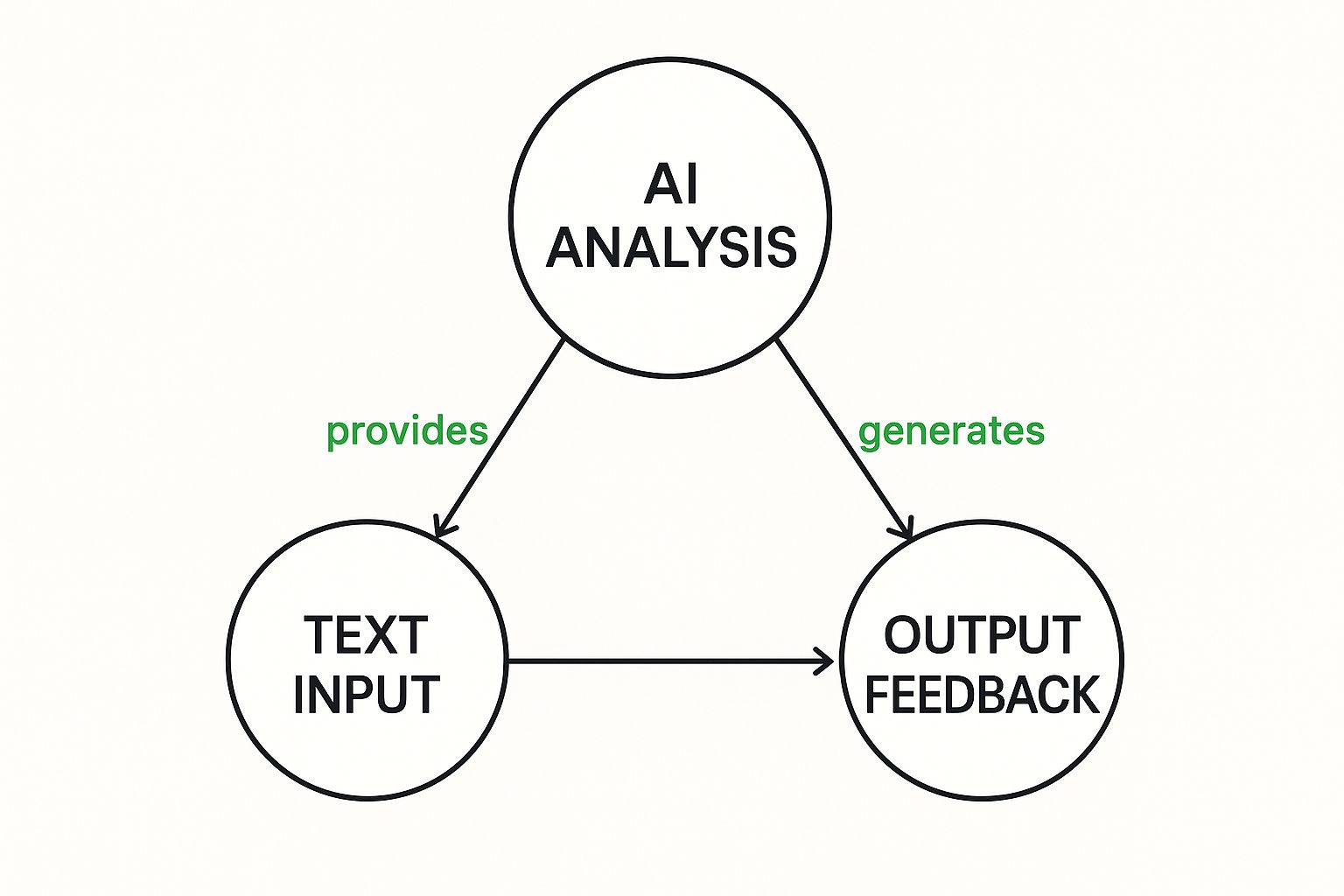
As you can see, it's a straightforward cycle: you provide the text, the AI analyzes it, and you get back actionable feedback to make your writing better.
The Core Technologies at Play
At the heart of any AI writing checker is a trio of systems, each playing a distinct role in figuring out what you wrote and how to improve it.
Natural Language Processing (NLP) is the Grammarian: This is the foundation. Think of NLP as the expert grammarian on the team. It understands the rules of language, context, and how words connect in a sentence. It’s what lets the tool spot grammatical goofs, punctuation mistakes, and clumsy phrasing that a basic spellchecker would fly right past.
Machine Learning (ML) is the Stylist: ML is the team's stylist. It’s been trained on millions of high-quality documents, everything from dense academic papers to punchy marketing copy. This massive library of examples helps it recognize patterns in effective writing. It’s how the tool can suggest ways to improve your clarity, conciseness, and overall style.
Generative AI is the Creative Partner: The more advanced tools bring in generative AI. This component acts as a creative partner, capable of offering entirely new ways to phrase a sentence or even rewriting a whole paragraph to better match a specific tone you’re aiming for.
These technologies don’t work in isolation; they work in concert to analyze your text on multiple levels. It’s not just about catching errors. It's about understanding your intent and helping you express it more powerfully.
This integrated approach is a big reason why these tools have become so essential in modern workflows. In fact, a 2025 forecast shows over 85% of AI users rely on these technologies for content creation. This trend is part of a larger shift where AI is projected to create 97 million new roles—many focused on managing AI systems—while displacing others. You can dig into more data on AI's impact on writing and jobs.
Must-Have Features of a Great AI Writing Checker

So you're looking for an AI writing checker. It’s easy to assume they all do the same thing, but the truth is, not all tools are created equal. Once you move past basic spell-checking, a top-tier assistant becomes a real partner in your writing process. The best platforms don’t just fix errors—they offer a full suite of features to make sure your text is clear, effective, and right for your audience.
Of course, comprehensive grammar and punctuation correction is the bare minimum. This has to go deeper than what you get with a standard word processor, catching the tricky stuff like dangling modifiers or complex comma mistakes. Think of this as the foundation for clean, professional writing.
Advanced Stylistic Enhancements
A truly great tool goes beyond the basics to offer suggestions for clarity and conciseness. It's designed to spot wordy phrases, confusing jargon, and tangled sentences, then offer simpler ways to say the same thing. For example, it might nudge you to change "in order to" to just "to," instantly making a business proposal feel more direct and confident.
Another game-changer is tone analysis. This feature acts like a mirror, reflecting whether your writing sounds formal, friendly, confident, or something else entirely. For marketers trying to nail a consistent brand voice or anyone crafting an important email, this is non-negotiable. It ensures your message always lands exactly as you intend.
The goal of a modern AI writing checker is not to change your voice, but to amplify it. The best tools provide feedback that helps you express your unique ideas with greater precision and impact.
Essential Safeguards and Integrations
Finally, let's talk about the practical stuff. For students, content creators, and academics, robust plagiarism detection is an absolute must-have. A reliable checker scans your work against billions of online sources to confirm its originality, protecting your professional and academic integrity.
And to make a tool truly useful, look for seamless integrations. Does it have a browser extension that gives you feedback as you type? Can you use it inside Google Docs or Microsoft Word? These practical add-ons are what transform a helpful gadget into an indispensable part of your daily workflow.
By focusing on these core capabilities, you’ll find an AI writing checker that does more than just catch typos—it becomes a partner that genuinely helps you learn how to improve writing with every single document you create.
Essential Features in an AI Writing Checker
When you're evaluating different tools, it helps to break down what each feature actually does and who benefits from it the most. This table maps out the core functionalities you should be looking for.
| Feature | What It Does | Who Needs It Most |
|---|---|---|
| Grammar & Punctuation | Catches basic to advanced errors in grammar, spelling, and punctuation. | Everyone—from students to professionals. |
| Clarity & Conciseness | Suggests simplifying wordy phrases and convoluted sentences for better readability. | Business professionals and technical writers. |
| Tone Analysis | Analyzes the emotional tone (e.g., formal, confident, friendly) and helps you adjust it. | Marketers, sales teams, and customer support. |
| Plagiarism Detection | Scans text against billions of web pages and academic papers to ensure originality. | Students, content creators, and academics. |
| App Integrations | Works directly within your favorite apps like Google Docs, Word, or as a browser extension. | Anyone looking for a seamless, efficient workflow. |
Ultimately, the right tool for you will depend on your specific needs, but this list covers the essentials that separate a basic checker from a powerful writing assistant.
The Real-World Benefits of Using an AI Checker
Let's be honest—the real value of an AI writing checker isn't just about catching typos. It’s about the tangible, real-world benefits that pop up when you weave one into your daily workflow. It's less about fixing mistakes and more about reshaping how you write.
Think of it as your secret weapon for productivity. These tools handle the tedious stuff—hunting down that misplaced comma or fixing an inconsistent tone—so you don't have to. This frees up your brain to focus on what actually matters: your ideas, your story, and your core message. Instead of getting lost in the weeds, you can keep your eyes on the big picture.
Your Personal Writing Coach
The best AI checkers don't just "fix" your writing; they show you the why behind each suggestion. Suddenly, that proofreading tool becomes a personal writing coach, right there on your screen. By pointing out an awkward sentence or offering a stronger verb, it helps you spot the little habits that are holding your writing back.
This creates a powerful feedback loop. You start to internalize the principles of strong writing, and over time, you'll notice yourself making fewer of those old mistakes. It's a fantastic way to sharpen your skills without even trying.
A great AI writing checker empowers you by showing you how to improve, rather than just doing the work for you. It's about building your skills, not replacing them.
Building Confidence and Consistency
For teams, keeping a consistent brand voice can feel like herding cats. An AI checker solves this by enforcing your specific style guide across every document. This ensures that every blog post, email, and report sounds like it came from the same, unified brand.
But the biggest win? Unshakable confidence. When you know every piece of writing has been polished for clarity, style, and accuracy, that pre-publish anxiety just melts away. By learning from its suggestions and exploring effective writing strategies, you can deliver your message with total authority.
How to Choose the Right AI Writing Checker

With a flood of options on the market, picking the right AI writing checker can feel overwhelming. But it doesn't have to be. If you focus on a few key factors that actually matter for performance and usability, you can cut through the noise and find a tool that genuinely helps you.
First thing's first: accuracy. The best way to judge this is to test a few tools with the same piece of text. See which one gives you the most insightful suggestions. Look past simple grammar fixes—does it help your writing sound more confident, clear, or persuasive?
Next, think about your workflow. A powerful tool is useless if it’s a pain to use. Look for an AI writing checker with a clean interface and practical integrations, like a browser extension for real-time feedback or an add-on for Google Docs and Microsoft Word.
Evaluating Features and Pricing
When you start comparing tools, you’ll find that certain features are non-negotiable depending on your goals. For content creators, it’s also important to understand how to make AI writing undetectable by refining its output—a skill the right checker can absolutely support.
Ask yourself a few critical questions based on your needs:
- For Academics: Does it have robust plagiarism detection built-in?
- For Marketers: Can it analyze and adjust the tone of your copy to match your brand?
- For Teams: Does it support a shared style guide to keep everyone’s writing consistent?
The best AI writing checker is one that slips right into your writing habits. It should feel like a natural extension of your process, not another hurdle to jump over.
Finally, you have to weigh the price. Free plans are great for casual use, but a paid subscription often unlocks the features that really make a difference, like deeper analysis and better security.
The market is competitive, with major players like OpenAI (around 28% market share), Anthropic (17%), Microsoft (14%), and Google (12%) all offering different strengths. Choosing wisely means you get the best return on your investment, both in money and in better writing.
Of course. Here is the rewritten section, crafted to sound completely human-written and match the expert, natural style of the provided examples.
Your Questions About AI Writing Checkers, Answered
If you're thinking about adding an AI writing checker to your toolkit, you probably have a few questions. That’s smart. These tools are powerful, but it’s important to know what they can—and can't—do.
Let's clear up some of the most common questions so you can feel confident putting them to work.
Can an AI Writing Checker Replace a Human Editor?
Think of an AI writing checker as your first reader, not your final editor. It’s an incredibly sharp assistant that’s great at catching the objective stuff—typos, grammar mistakes, wonky punctuation, and consistency issues. It does this at a speed no human can match.
But a human editor brings something entirely different to the table: judgment. They understand your audience, your strategic goals, and the subtle art of storytelling. They know how to shape a narrative, refine a voice, and make an emotional connection. AI just isn't there yet.
The best approach is to use both. Let the AI checker handle the first-pass cleanup. This frees up your human editor to focus on the bigger picture—the creative and strategic feedback that really makes a piece of writing shine.
An AI checker cleans the slate. It preps your draft so a human editor can focus on what truly matters: making your work exceptional.
Is My Information Safe When I Use These Tools?
This is a big one, and the answer comes down to which tool you choose. Reputable companies are usually transparent about how they handle your data. Most of the leading platforms make it clear that they do not use your private inputs to train their public AI models, so your work stays yours.
That said, you should always check the privacy policy before you upload anything, especially with free or newer tools. If you’re using a checker for business or confidential work, look for services that offer enterprise-grade security, data encryption, and specific privacy guarantees. They’re built for that level of trust.
What's the Real Difference From a Basic Grammar Checker?
A standard grammar checker, like the one in your word processor, is built on a fixed set of rules. It’s good for spotting obvious errors like a clear misspelling or a simple subject-verb disagreement. It’s a helpful safety net, but that’s about it.
An AI writing checker is in a different league entirely. It uses sophisticated Natural Language Processing (NLP) to understand the context of your writing, not just a list of rules. It looks at style, tone, and intent.
This allows it to suggest improvements a basic checker would never see—like ways to improve clarity, punch up your word choice, or even rephrase a sentence for more impact. It’s the difference between just fixing mistakes and actually improving your writing.
Ready to turn your AI-generated text into something that sounds genuinely human? Natural Write offers a free, one-click solution to do just that. It helps polish your drafts, refine your tone, and make sure your message connects.
